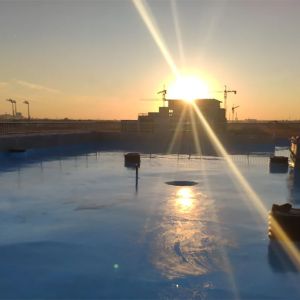| Sign In | Join Free | My himfr.com |
|
| Sign In | Join Free | My himfr.com |
|
| Ask Lasest Price | |
| Brand Name : | Zhuhai Feiyang |
| Model Number : | Waterproofing Mechanism of Polyaspartic |
| Certification : | REACH, ISO 9001-2008, ISO 14001-2004 |
| Payment Terms : | L/C, T/T |
| Supply Ability : | More than 20000 tons per year |
| Delivery Time : | 7 days after orders comfirmed |
The waterproofing capability of polyaspartic originates from its unique chemical structure, physical characteristics, and application advantages, forming a continuous, dense, and highly elastic protective layer that effectively blocks water penetration.
Molecular Structure: Dense Crosslinked Network
1. Three-dimensional Crosslinked Structure
Polyaspartic is formed by the reaction between isocyanate (-NCO) and aspartic ester (-NH2), generating carbamate groups (-NH-CO-O-) to create a highly crosslinked network.
The intermolecular spacing is very small (nanometer scale), preventing water molecules (diameter ~0.28 nm) from penetrating easily, achieving a permeability coefficient of less than 1×10-13cm²/s, close to the barrier performance of aluminum.
2. Hydrophobic Groups
Nonpolar carbon chains (e.g., hexamethylene structure of HDI) in aliphatic isocyanate backbones impart hydrophobic properties to the material, resulting in a water contact angle of over 100° (superhydrophobic standard >150°), causing water to form droplets and roll off easily, reducing wetting.

Film-forming Properties: Seamless Continuous Barrier
1. Solvent-free Spray Application
Polyaspartic uses a 100% solids formulation, which rapidly cures after spraying (Touch dry time ≤ 1-2 hours), creating a seamless, continuous film layer, eliminating leakage risks from overlaps or pinholes common in traditional membranes or coatings.
2. Adaptive Base Surface
Its high elasticity (elongation rate >300%) covers small substrate cracks (≤2mm) and remains intact despite substrate thermal expansion and contraction, preventing stress-induced cracking and leakage.
Functional Design: Multiple Protection Mechanisms
1. Hydrostatic Pressure Resistance
Polyaspartic coatings can withstand hydrostatic pressures exceeding 1.0 MPa (equivalent to 100 meters of water column), far exceeding the national standard Class I waterproof requirement of 0.3 MPa.
Test data: According to GB/T 23445-2009 standard, no leakage occurred under continuous 24-hour exposure to 0.3 MPa water pressure.
2. Chemical Corrosion Resistance
The crosslinked network blocks penetration by corrosive media such as acids, alkalis, and salts, preventing chemical erosion-induced cracking of substrates (e.g., concrete, metal), indirectly enhancing waterproof durability.
3. Microbial Corrosion Resistance
Dense surfaces inhibit attachment by mold and algae, preventing biodegradation-induced damage to coatings (traditional asphalt-based materials are susceptible to microbial decomposition).

Practical Application Validation
1. Building Roof Waterproofing
Case: A commercial complex roof coated with 2mm thick polyaspartic remained leak-free after 10 years of exposure to heavy rain and intense sunlight, reducing maintenance costs by 80%.
2. Underground Engineering Waterproofing
Case: During subway tunnel construction, polyaspartic passed 0.8 MPa water pressure tests, effectively resisting groundwater penetration.
3. Pool/Reservoir Protection
Case: Inner wall coatings for drinking water pools passed GB/T 17219-1998 hygienic standards, ensuring no leaching even with long-term immersion, thus safeguarding water quality.
Comparison with Traditional Waterproofing Materials

Technological Optimization Directions
1. Enhancing Hydrophobicity
Add nano-silica or fluorocarbon modifiers to increase the contact angle to >150°, achieving superhydrophobic effects.
2. Self-healing Functionality
Incorporate microencapsulated healing agents that automatically release repairing components upon water contact with microcracks, restoring waterproof integrity.
3. Smart Monitoring
Embed conductive nanomaterials for real-time monitoring of coating integrity, providing early warnings for potential leakage risks.
Polyaspartic achieves efficient and long-lasting waterproofing performance through its "dense crosslinked molecular structure," "seamless film-forming properties," and "multiple protective mechanisms." Its strengths lie not only in water blockage but also in its adaptability to complex environments and resistance to chemical and biological erosion, making it the preferred material for high-end waterproof projects. With technological advancements, the waterproofing applications of polyaspartic in green construction and underground engineering will further expand.
Feiyang has been specializing in the production of raw materials for polyaspartic coatings for 30 years and can provide polyaspartic resins, hardeners and coating formulations.
Feel free to contact us: marketing@feiyang.com.cn
Our products list:
Contact our technical team today to explore how Feiyang Protech’s advanced polyaspartic solutions can transform your coatings strategy. Contact our Tech Team

|




